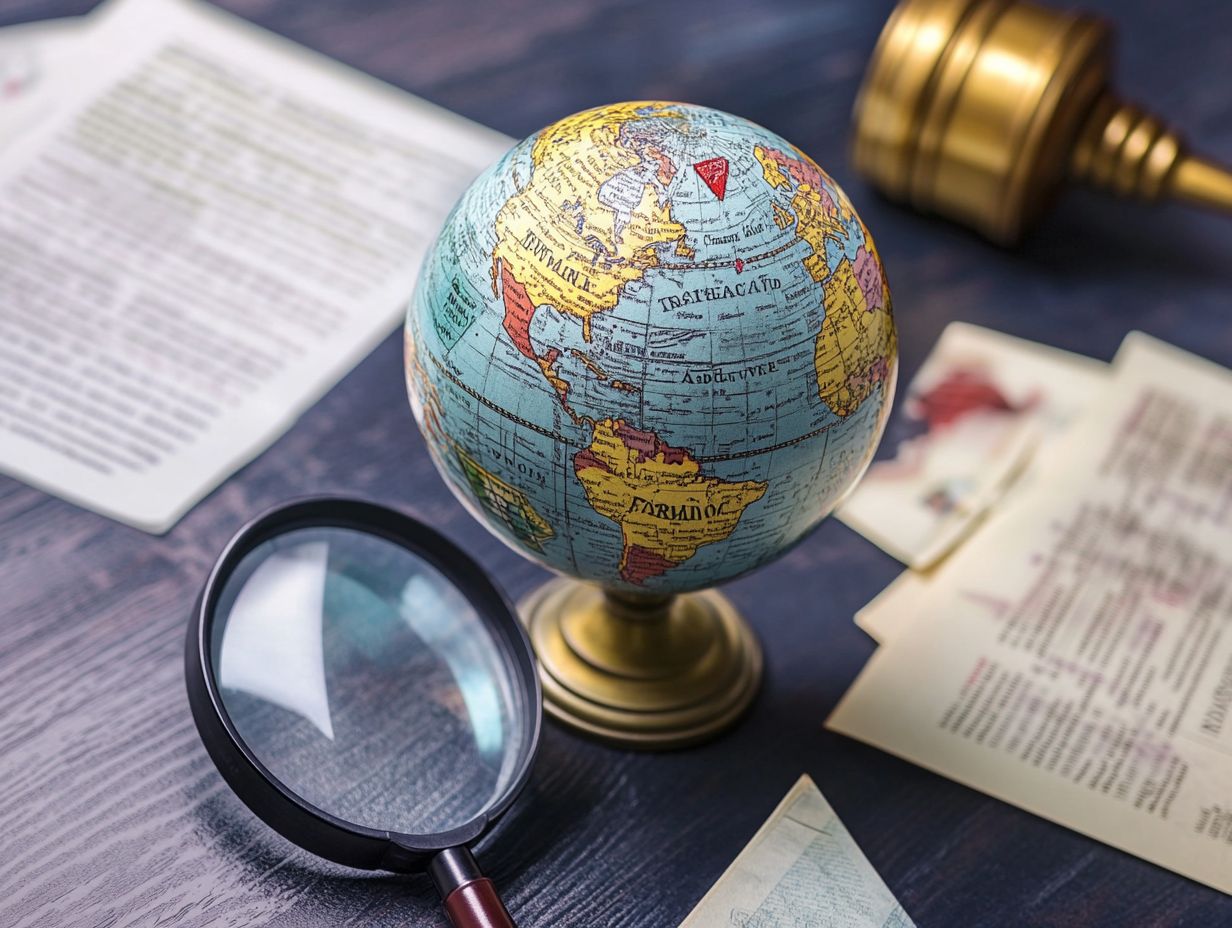How to Protect Your Trademark Internationally
In today s global marketplace, safeguarding your brand identity is vital. Understanding trademark protection serves as the foundation for shielding your business from infringement and ensuring that your unique products or services stand out.
This article delves into the essentials of trademark law, outlining key international regulations and necessary steps for effective protection.
It also tackles common challenges, such as counterfeiting and navigating varying legal landscapes, equipping you with the knowledge to defend your trademark on a global scale.
Contents
- Key Takeaways:
- Understanding Trademark Protection
- International Trademark Laws and Regulations
- Country-Specific Regulations
- Steps to Protect Your Trademark Internationally
- Research and Registration Process
- Enforcement and Monitoring Strategies
- Common Challenges and How to Overcome Them
- Conclusion
- Frequently Asked Questions
- What is a trademark and why is it important to protect it internationally?
- What are the steps to protect a trademark internationally?
- What is the Madrid System and how does it work?
- What is the difference between a trademark and a copyright?
- Can I protect my trademark in every country?
- What happens if someone infringes on my trademark internationally?
Key Takeaways:

Registering your trademark internationally is crucial for protecting your brand’s identity and reputation.
Before expanding globally, research and understand the trademark laws and regulations in each country to ensure proper protection.
Enforce and monitor your trademark by regularly checking for infringement and counterfeiting, while being aware of cultural and legal differences in different countries.
Understanding Trademark Protection
Trademark protection is essential if you’re looking to safeguard your intellectual property across various jurisdictions, especially within the European Union (EU) and other international markets.
Grasping the nuances of trademark registration and the uniqueness necessary to establish a mark is crucial for protecting your goods and services.
A well-registered trademark can shield you from infringement and provide a competitive edge, allowing you to navigate the complexities of trademark law with confidence.
What is a Trademark and Why Protect It?
A trademark is your unmistakable sign, design, or expression that sets your products or services apart from the competition. It grants you specific rights and protection.
This unique identifier does more than just mark your origin; it builds consumer trust by assuring customers they’re investing in a consistent level of quality.
Trademarks come in various forms think logos, slogans, and even sounds or colors each playing a crucial role in the marketplace. Protecting your trademarks is essential because uniqueness ensures that your goods or services remain easily recognizable.
Though the registration process can be complex, it offers the legal support you need to prevent unauthorized use and reduce the risk of brand dilution. Securing your trademark is not just important; it s an exciting opportunity to invest in your brand’s future.
International Trademark Laws and Regulations
International trademark laws and regulations are vital for ensuring the protection of your intellectual property across borders, helping you navigate various legal landscapes confidently.
Organizations like the World Intellectual Property Organization (WIPO) and agreements such as the Madrid Protocol offer valuable frameworks that streamline the registration and enforcement of trademarks in multiple countries.
Understanding these international mechanisms is crucial if you aim to safeguard your products and services on a global scale.
Key Laws and Agreements

Understanding key laws and agreements like the Madrid Protocol, as well as regulations from the USPTO and EUIPO, is essential for navigating the complex landscape of international trademark protection.
These frameworks are vital for harmonizing trademark registration processes, making it easier for you to secure your intellectual property across multiple jurisdictions.
For example, the Madrid Protocol simplifies the application process for trademark owners, allowing you to file a single application that can be extended to numerous member countries. This means your brands can enjoy protection in diverse markets with far less hassle.
The guidelines set forth by the USPTO and EUIPO establish clear standards for what qualifies as a valid trademark, minimizing the potential for disputes. The significance of these agreements is immense; they not only facilitate enforcement actions against counterfeiting but also bolster global trade by instilling confidence in brand integrity.
Take action today! Consider consulting legal experts or conducting more research to ensure your trademark is protected effectively.
Country-Specific Regulations
Country-specific regulations regarding trademarks can differ significantly. These differences shape how you protect your intellectual property in regions like Europe, China, and India.
For instance, the European Union offers a streamlined trademark registration process through the European Union Intellectual Property Office. In contrast, China requires that trademarks be registered within the country where you operate. This means you must develop a solid grasp of local trademark laws.
In India, the application process demands specific documents and often involves navigating a complex examination procedure. Consulting local experts is crucial to successfully manage these challenges.
Grasping these differences is crucial for protecting your brand globally!
Steps to Protect Your Trademark Internationally
Protecting your trademark internationally requires a series of strategic actions. Start with meticulous research, registration, and consider how to trademark your brand name effectively to safeguard your intellectual property rights in the global marketplace.
The trademark registration process typically begins with a comprehensive application. You must demonstrate the distinctiveness and proper usage of your mark across various jurisdictions.
You must implement effective enforcement strategies to protect your brand and mitigate the risk of infringement.
Research and Registration Process
The research and registration process for trademarks is critical. It requires thorough evaluation to establish distinctiveness before submitting an application to the relevant trademark office.
This initial research helps you identify existing trademarks and assesses their closeness in the market. Ensuring that your proposed trademark isn t too similar to others is essential.
Understanding the nuances of distinctiveness is vital. Trademarks that are generic or merely descriptive often face greater challenges during registration.
After conducting a comprehensive search and validating the uniqueness of your trademark, prepare your application meticulously. Include key details and submit it to the appropriate authority. This diligent approach minimizes the risk of denial and strengthens the trademark s standing, enhancing your brand’s recognition in a competitive marketplace.
Enforcement and Monitoring Strategies

Enforcement and monitoring strategies are essential for maintaining your trademark rights and preventing infringement. They empower you to take proactive measures against potential threats to your intellectual property.
To protect these invaluable assets, employ various techniques, including:
- Conducting regular online searches
- Utilizing specialized software to track unauthorized use
- Engaging in keyword monitoring to identify potential brand confusion
Staying vigilant is crucial! Act quickly to protect your brand. Your legal options include:
- Sending cease-and-desist letters
- Filing lawsuits
- Seeking oppositions during trademark registrations
By proactively engaging in these efforts, you can significantly reduce the risks associated with trademark infringement and uphold the integrity of your brand.
Common Challenges and How to Overcome Them
You will encounter several common challenges in trademark protection. These include issues of infringement, counterfeiting, and complexities arising from differing regulations across countries.
Tackling these challenges demands a nuanced understanding of international trademark laws. You must navigate cultural and legal differences with skill.
To effectively overcome these hurdles and safeguard your intellectual property rights, proactive measures such as robust monitoring and well-crafted legal strategies are essential.
Conclusion
In summary, protecting your trademark on a global scale requires a thorough understanding of country-specific regulations, a meticulous approach to research and registration, and effective enforcement and monitoring strategies. By taking these steps, you can secure your brand’s identity and reputation in the international marketplace.
Dealing with Infringement and Counterfeiting
Dealing with infringement and counterfeiting presents a formidable challenge for your business. It’s essential to adopt a proactive strategy to safeguard your trademark rights and uphold your brand s integrity.
These violations can take many forms. They range from unauthorized use of your logos to counterfeit products and imitation services that mislead consumers. Such activities dilute the value of well-established brands and undermine consumer trust, leading to significant financial repercussions.
When faced with these issues, you may find it necessary to take legal action. This could involve filing lawsuits, seeking injunctions, or exploring alternative dispute resolutions to protect your intellectual property.
By grasping the intricacies of trademark law and the available remedies, you empower yourself to address infringement effectively and maintain your competitive position in the market.
Navigating cultural and legal differences is crucial for your business if you aim to protect your trademarks on an international scale. Diverse regulations across countries can significantly influence your trademark strategies.
Variations often arise from each nation s distinct cultural norms, traditions, and legal frameworks. This leads to unique methods for trademark registration and enforcement. For instance, some jurisdictions may prioritize the first person to register a trademark, while others may favor the first person to use it in commerce.
To successfully adapt, invest time in understanding local customs and engage with local legal experts. They can offer valuable insights into specific regulations and enforcement practices. This proactive approach helps you avoid potential disputes and enhances the overall effectiveness of your trademark management globally.
Frequently Asked Questions

What is a trademark and why is it important to protect it internationally?
A trademark is a recognizable word, phrase, symbol, or design that identifies and distinguishes the source of the goods or services of one party from those of others. Protecting your trademark internationally ensures that it is legally recognized and prevents others from using it without permission. This maintains your brand’s unique identity and reputation.
What are the steps to protect a trademark internationally?
The first step is to register your trademark in your home country. Then, you can file for international protection through the Madrid System. This system allows for a single application to be filed in multiple countries. Alternatively, you can file directly with individual countries or through regional trademark systems, such as the European Union Intellectual Property Office.
What is the Madrid System and how does it work?
The Madrid System is a centralized system for registering and managing trademarks internationally. It lets you file a single application in multiple countries. This reduces the time and cost of protecting your trademark globally. Once the application is approved, your trademark is protected in all designated countries, subject to their laws and regulations.
What is the difference between a trademark and a copyright?
A trademark protects the name, logo, or slogan of your brand, while a copyright protects original creative works, such as books, music, and artwork. Both are important for protecting your intellectual property, but they serve different purposes and require different forms of registration.
Can I protect my trademark in every country?
Yes, you can protect your trademark in most countries around the world. However, some countries have laws and regulations that may make it more difficult or costly to do so. It’s important to research and understand the trademark laws of each country where you wish to protect your trademark.
What happens if someone infringes on my trademark internationally?
If someone infringes on your trademark internationally, you can take legal action in the country where the infringement occurred. This may involve hiring a local attorney and navigating the legal process in that country’s court system. It’s crucial to have a strong understanding of international trademark laws and how to enforce them to protect your trademark effectively.
Ready to protect your trademark? Contact us today!
Protecting your trademark is vital for maintaining your brand’s reputation and integrity. By understanding the international landscape and legal implications, you can navigate the complexities of trademark protection efficiently.






